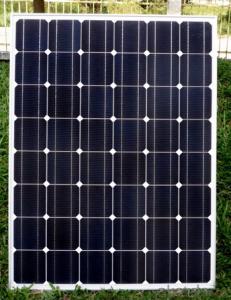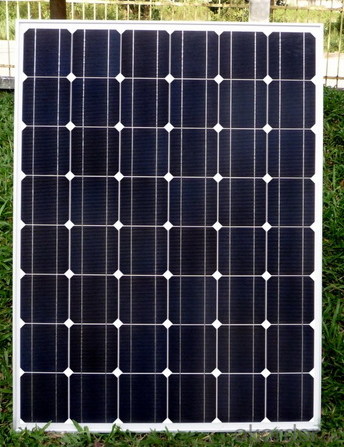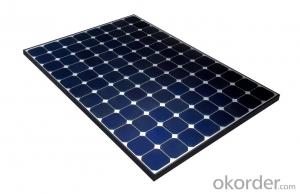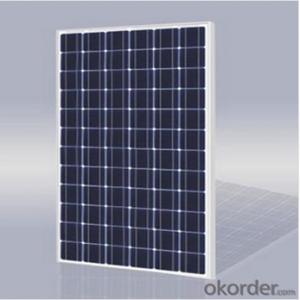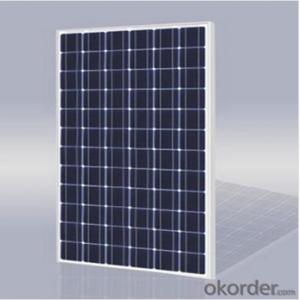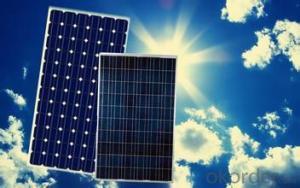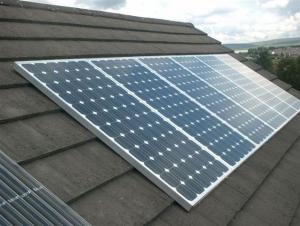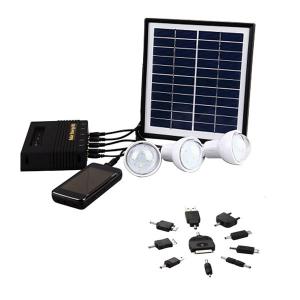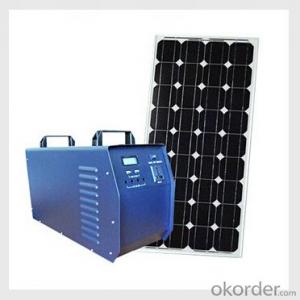Baywa Solar Energy Systems 35.5kw CNBM Monocrystalline Silicon Panel for Home Use
- Loading Port:
- Tianjin
- Payment Terms:
- TT OR LC
- Min Order Qty:
- 50 watt
- Supply Capability:
- 1000 watt/month
OKorder Service Pledge
OKorder Financial Service
You Might Also Like
Specification
35.5KW CNBM Monocrystalline Silicon Panel for Home Using
Production description
Solar energy is radiant light and heat from the Sun harnessed using a range of ever-evolving technologies such assolar heating, photovoltaics, solar thermal energy, solar architecture and artificial photosynthesis.
It is an important source of renewable energy and its technologies are broadly characterized as either passive solar oractive solar depending on the way they capture and distribute solar energy or convert it into solar power. Active solar techniques include the use of photovoltaic systems
The large magnitude of solar energy available makes it a highly appealing source of electricity. The United Nations Development Programme in its 2000 World Energy Assessment found that the annual potential of solar energy was 1,575–49,387 exajoules (EJ). This is several times larger than the total world energy consumption, which was 559.8 EJ in 2012.
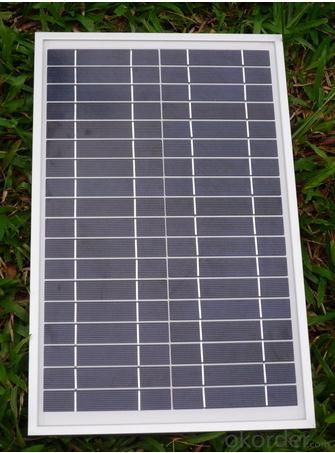
Feature
1.High conversion efficiencies resulting in superior power output performance.
2.Outstanding power output even in low light or high temperature conditions
3.Optimized design for ease of soldering and lamination
Physical characteristic
1. Rigorous quality control meets the highest international standards.
2. High-transmissivity low-iron tempered glass, strong aluminium frame.
3. Using UV-resistant silicon.
4. IS09001/14001/CE/TUV/UL
Packaging
26pcs in one carton 6pallets in 20foot container 14pallets in 40 foot container.
- Q: How do solar energy systems impact energy resilience during natural disasters?
- Solar energy systems can significantly enhance energy resilience during natural disasters. These systems provide a reliable and independent source of electricity, enabling critical infrastructure and essential services to continue functioning even when the main power grid is disrupted. Solar panels can continue generating electricity as long as there is sunlight available, reducing the reliance on fuel-dependent generators and minimizing the risk of fuel shortages during emergencies. Additionally, solar energy systems can be paired with battery storage, allowing excess energy to be stored and used during nighttime or cloudy periods. This combination ensures a continuous power supply, enabling emergency response efforts, communication networks, and healthcare facilities to operate, thereby enhancing overall energy resilience during natural disasters.
- Q: Can a solar energy system be installed on a concrete roof?
- Yes, a solar energy system can be installed on a concrete roof. In fact, concrete roofs are one of the most ideal surfaces for solar panel installation. Concrete roofs are typically flat, stable, and durable, providing a solid foundation for the panels. Additionally, concrete roofs often have ample space and are not obstructed by nearby trees or buildings, allowing for maximum sunlight exposure. The installation process involves securing the panels to the concrete roof using special mounting systems designed to withstand the weight and ensure a secure attachment. Overall, concrete roofs are a great choice for solar energy system installation.
- Q: What is the impact of saltwater exposure on solar panels?
- The impact of saltwater exposure on solar panels can be significant and detrimental. Saltwater contains high levels of corrosive salts, such as sodium chloride, which can corrode the materials used in solar panels. This corrosion can lead to the deterioration of the panel's components, including the frame, wiring, and connectors. The primary concern with saltwater exposure is the damage it can cause to the protective coatings on the solar panel surfaces. These coatings are designed to protect the cells from environmental factors, including moisture and UV radiation. When saltwater comes into contact with these coatings, it can break them down, leading to the exposure of the solar cells. Once the cells are exposed, they become vulnerable to the corrosive effects of saltwater. The corrosive salts can attack the metal contacts and connections within the solar panels, leading to a decrease in their efficiency and overall performance. This corrosion can also cause electrical shorts or open circuits, which can render the solar panels completely non-functional. Furthermore, saltwater exposure can also lead to the accumulation of salt deposits on the surface of the solar panels. These deposits can reduce the amount of sunlight reaching the solar cells, thereby reducing their energy production. The salt deposits can also create an additional barrier between the sunlight and the cells, further decreasing their efficiency. To mitigate the impact of saltwater exposure, it is crucial to implement proper maintenance and cleaning procedures for solar panels in coastal or saltwater-rich environments. Regular cleaning using a non-abrasive solution can help remove salt residues and prevent the buildup of deposits. Additionally, using materials that are resistant to corrosion and saltwater, such as marine-grade aluminum or stainless steel for panel frames and connectors, can help prolong the lifespan of solar panels in these harsh environments. In conclusion, saltwater exposure can have a detrimental impact on solar panels, leading to corrosion, reduced efficiency, and potential failure of the system. Proper maintenance and the use of corrosion-resistant materials are essential to minimize the negative effects of saltwater exposure and ensure the long-term performance of solar panels in coastal or saltwater-rich areas.
- Q: Can solar energy systems be used in areas with high levels of wildlife activity?
- Yes, solar energy systems can be used in areas with high levels of wildlife activity. While it is true that wildlife can pose some challenges for solar energy systems, there are several ways to mitigate these issues. One of the primary concerns is the risk of damage to the solar panels by large animals or birds. However, there are various protective measures that can be taken to prevent this. For instance, installing fencing or barriers around the solar panels can help keep wildlife away. Additionally, using anti-reflective coatings on the panels can reduce the likelihood of bird collisions. Another concern is the impact of solar energy systems on wildlife habitats. It is crucial to choose the location of the solar panels carefully, considering the existing wildlife activity in the area. By conducting thorough environmental impact assessments and engaging with local wildlife experts, it is possible to minimize any potential negative effects on wildlife habitats. Moreover, solar energy systems can actually benefit wildlife in some cases. For example, solar farms can provide additional shelter and shade for some species, and the open spaces underneath the panels can create new habitats for ground-dwelling animals. Overall, while there may be some challenges, with proper planning and mitigation strategies, solar energy systems can be successfully utilized in areas with high levels of wildlife activity.
- Q: What is the role of charge controllers in a solar energy system?
- The role of charge controllers in a solar energy system is to regulate and control the flow of electricity between the solar panels and the batteries. They prevent overcharging of batteries by regulating the voltage and current, which helps prolong the battery's lifespan and ensures efficient and safe operation of the entire system.
- Q: Can solar energy systems be used for agricultural applications?
- Yes, solar energy systems can be used for agricultural applications. Solar panels can be used to power various agricultural operations such as irrigation systems, water pumps, and electric fences. Additionally, solar energy can be used in greenhouses to provide heating, lighting, and ventilation. Overall, utilizing solar energy in agriculture can help reduce reliance on traditional energy sources and contribute to sustainable farming practices.
- Q: How do solar energy systems impact air conditioning costs?
- Solar energy systems can significantly reduce air conditioning costs by providing a renewable and cost-effective source of power. By harnessing the sun's energy to generate electricity, solar panels can power air conditioning units directly, eliminating or reducing the need for grid electricity. This can result in lower energy bills and reduced dependence on fossil fuels, leading to a more sustainable and environmentally-friendly cooling solution.
- Q: Are there any financing options available for solar energy systems?
- Yes, there are several financing options available for solar energy systems. These include solar loans, solar leases, power purchase agreements (PPAs), and government incentives such as tax credits and rebates.
- Q: Can solar energy systems be used in areas with high humidity?
- Yes, solar energy systems can be used in areas with high humidity. While high humidity may slightly reduce the efficiency of solar panels, it does not render them ineffective. Solar panels are designed to withstand various weather conditions, including high humidity. They can still generate electricity, although their output might be slightly lower compared to areas with lower humidity. Overall, solar energy systems can still be effectively utilized in areas with high humidity.
- Q: How do solar energy systems affect electricity bills?
- Solar energy systems can significantly reduce electricity bills by generating renewable energy from the sun. By using solar panels to harness solar energy, households can generate their own electricity and become less reliant on the grid. This can lead to substantial savings on monthly bills, as the energy produced by the solar system offsets the need for electricity from the utility company. In some cases, solar energy systems can even result in net metering, where excess energy generated is fed back into the grid, further reducing or eliminating electricity bills altogether.
Send your message to us
Baywa Solar Energy Systems 35.5kw CNBM Monocrystalline Silicon Panel for Home Use
- Loading Port:
- Tianjin
- Payment Terms:
- TT OR LC
- Min Order Qty:
- 50 watt
- Supply Capability:
- 1000 watt/month
OKorder Service Pledge
OKorder Financial Service
Similar products
Hot products
Hot Searches
Related keywords
